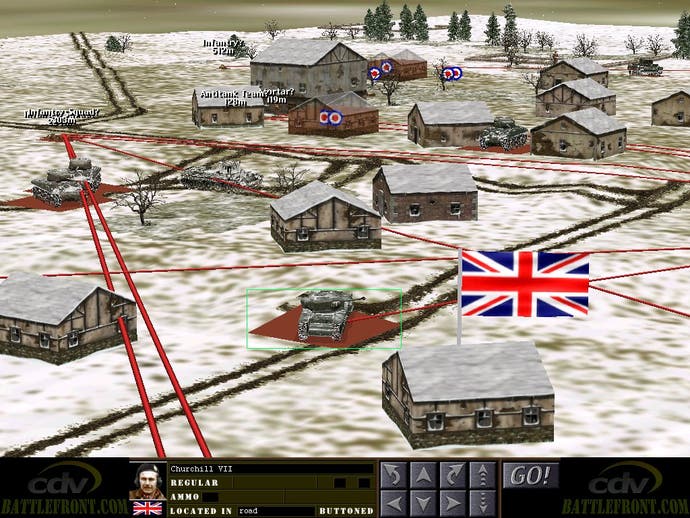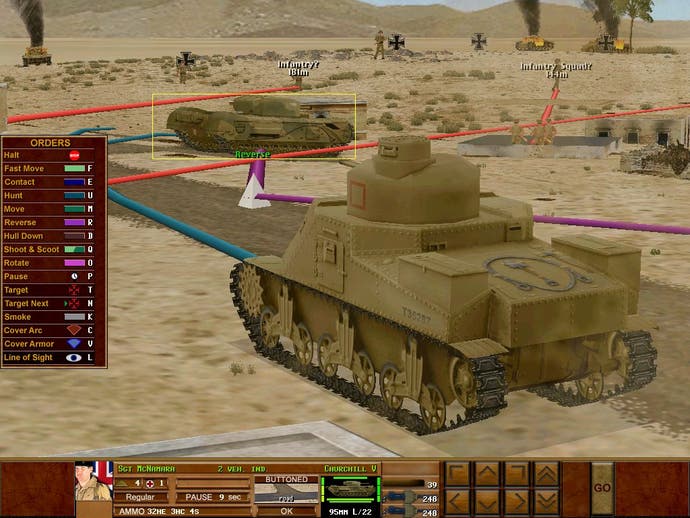Combat Mission: The story so far
Oliver adopts the missionary position.
At the start of 2000, PC wargaming was in a rather sorry state. While other genres had been quick to exploit new technology and explore new ideas, developers specialising in realistic military strategy games were still churning out pretty much the same games they had been churning out five or even ten years earlier. Titles tended to have a strong board-game feel with action split into turns and 2D terrain divided into hexagons. AI tended to be weak, spectacle completely non-existent.
Into this uninspiring fossilised world, in the summer of 2000, came the extraordinary Combat Mission: Beyond Overlord. Created by a trio of Americans with help from numerous Internet volunteers, CMBO offered realism and drama, depth and user-friendliness. For the first time ever wargamers weren't forced to hover above the battlefield like expectant vultures, they could actually observe the action from the perspective of a grunt or a tank commander. For the first time ever those grunts and tank commanders weren't brainless automatons; they actually behaved like they'd read a training manual or two, and cared whether they lived or died.
Order And Chaos
Borrowing a clever idea from a game called Tac Ops, Big Time Software split Combat Mission scraps into sixty-second chunks. At the end of a minute of hands-off 'real-time' action, the clock stopped, vehicles and soldiers froze, and there was an opportunity to issue fresh orders. Once commands had been given, the clock restarted and the player sat helpless through another minute of tense realistic combat.
The beauty of this system was that it forced you to think and plan rather than rely on deft mouse skills. It also imitated the limitations of real command remarkably well. Real squad leaders and company commanders don't have instant control of their forces - war is much messier than that.
Because you're only getting input every sixty seconds it's obviously vital that your troops are capable of a little independent thought. Here CMBO really impressed. Say during the orders phase you'd given one of your small Daimler armoured cars a move command that sent it across a field, through a wood and into a lane; if, during the subsequent action phase, it bursts out of the trees onto the lane and finds itself facing a previously unseen Panther tank (unspotted units are effectively invisible) then, assuming it isn't immediately torn apart by a well-aimed 88mmm shell, it will probably decide to ignore your orders, fire a smoke shell, and reverse at top speed back into the safety of the wood. Very clever, no?
Everyone's a coward

Unlike the attractive but improbable WW2 RTS games that game charts, CMBO's recreation of fighting men acknowledges that the normal human reaction to zipping shrapnel and flying lead is to hug the earth or scamper for cover. Give your infantry silly, unrealistic commands (Mount a frontal attack on that pillbox boys! Dash across that snowy bog, through that minefield and tangled barbwire, then KO that Tiger tank with your bare frostbitten hands! ...) and, usually, a few turns down the line they'll be corpses or cowering, uncontrollably, in some thicket or cottage. This is one of very very few PC games where employing historical tactics actually produce historical results most of the time.
Arriving at Combat Mission with only Codename Panzers or Blizkrieg experience under your belt, one of the aspects you'll probably be most struck by is the brutality and subtlety of the armoured combat. In this game it's possible - if you're careless or very unlucky - to start an action phase with half-a-dozen shiny Shermans or pristine Panzers and end it, sixty seconds later, with nothing but a mound of burning scrap iron to your name. Big Time Software model the intricacies of tank armour and the capabilities of anti-tank weapons with incredible accuracy meaning that one shot, whether it's from a bazooka, AT gun or tank - is often enough to stop an armoured giant in it's turf-clogged caterpillar tracks. The suddenness with which your treasured tanks can be taken from you can be a bit off-putting at first but quickly you find yourself polishing your tactics. Perhaps if I use infantry to scout ahead, or bring down a smoke barrage to hide my movement, or plaster that worryingly quiet treeline with suppressing artillery rounds, then my advancing armour will have a better chance? Perhaps if I try and think like a real WW2 commander I might actually grind-out a victory here.
Fatal Fate

There are some situations in CM battles that no amount of background knowledge or natural cunning will help you with. When a friendly plane bombs your convoy by mistake or a wayward mortar round from your own battery kills one of your best commanders sending the troops around him into a panic, there's little you can do but mutter 'C'est la guerre' and admire the credible unpredictability. Luck, of course, works both ways. Most veteran Combat Missionaries will have a few tales of battles in which, against-all-odds, one of their tiny peashooter-equipped tank vanquished a much mightier adversary. Compared to the drab inevitability of much strategy game combat, CM is a breath of fresh air.
But of course it's not perfect. CMBO came with a generous selection of single battles and multi-engagement operations and a good skirmish generator (with random maps) but there was no strategy layer so play could feel a little disconnected at times. The 3D visuals were amazing by genre standards but no great shakes when compared to other mainstream games around at the time. Technological limitations meant that when one of your units spotted an enemy all of your units instantly became aware of that enemy too. Convoys were tricky to control... the game had a few small shortcomings but none that stopped it grabbing rave reviews just about everywhere.
Beyond Beyond Overlord

CMBO focussed on the fighting on the Western Front from the Normandy Landings to the fall of the Reich. The second CM title, Combat Mission: Barbarossa to Berlin (known as Combat Mission 2 in Europe) appeared in 2002 and explored the combat on the chilly Eastern Front. Understandably, few fundamentals had been altered though graphics were enhanced, the order selection was bigger and more sophisticated, the warfare even more accurate. A third game, the sandy Combat Mission: Afrika Korps (called CM3 in Europe) arrived in 2003. It was another rich, rewarding creation pounced on by all those after a fabulous and faithful solo and multiplayer wargame (all of the trio offer LAN, Internet, and incomparable PBEM MP).
The big news in the bustling CM community at the moment is the announcement of Combat Mission: Shock Force, the fourth title in the CM dynasty and the first, since CMBO, to utilise a brand new engine. Due out in roughly six months, it promises many tantalising improvements to the tried and trusted CM formula including a campaign, 1-to-1 infantry representation (in the previous games squad representation was stylised) and more detailed urban warfare. The devs' decision to set the game in a fictional contemporary Middle Eastern war has ruffled a few feathers amongst the forum faithful at Battlefront.com. Some fans are even talking about giving CM:SF a miss. Given the quality of the previous CM games, the refuseniks could well end-up missing out on one of the best strategy games of 2006.
